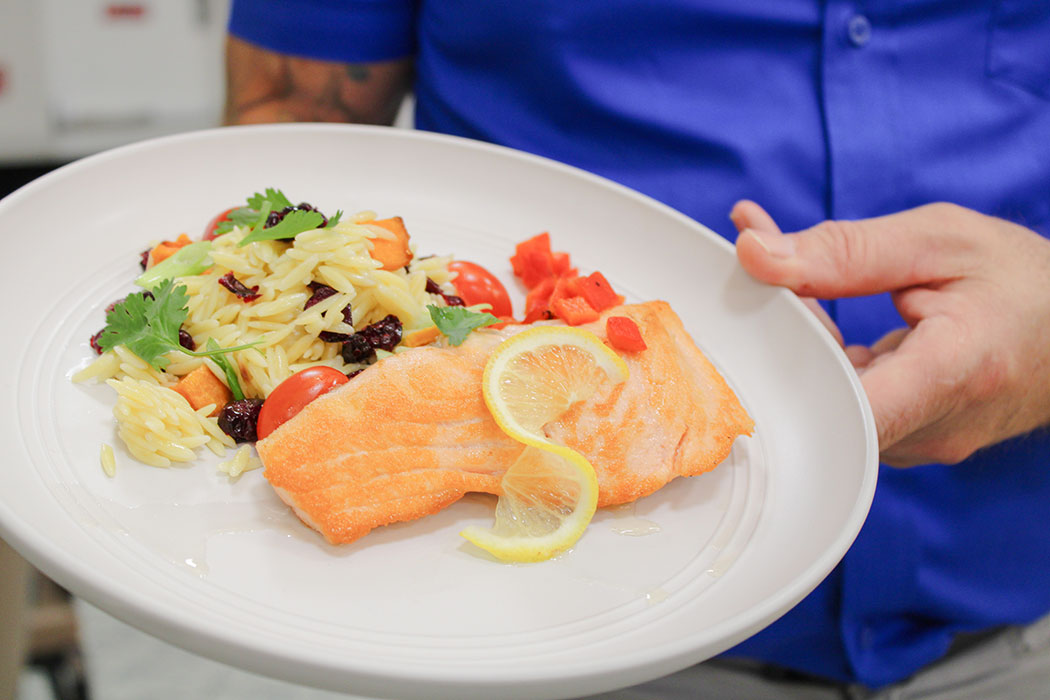
Heart health tips for seniors
By Larissa Sgarlato, RDN
February is American Heart Month, a time when people of all ages are encouraged to focus on heart-healthy living. For seniors, it’s especially important as people 65 and older are at a higher risk for heart attack, stroke, coronary artery disease and heart failure. However, the good news is it’s never too late to strengthen your heart. Not only can seniors prevent heart disease, but there’s evidence that heart disease symptoms can be lessened or reversed by making a few easy-to-follow lifestyle changes.
Whether living at home or in a senior living community, older adults should focus on two things – diet and physical activity. Since mobility can be a challenge for some older adults, it’s recommended to ask your provider or a physical therapist to see what exercises are best. At Gulf Coast Village, Cape Coral’s only continuing care retirement community, residents can choose from a variety of fitness programs and may work with a physical therapist or rehabilitation specialist to create a fitness plan. When done consistently, low-impact cardio such as short walks or simple chair exercises can be beneficial to managing or preventing heart disease.
In addition to routine exercise, one of the most attainable ways to promote heart health is making changes to your diet. Based on the eating habits of countries that border the Mediterranean Sea, the Mediterranean diet is known for its positive impact on managing or reversing chronic diseases such as coronary disease and diabetes. This diet is linked to a lower risk of high cholesterol and high blood pressure and consists of easy diet modifications, such as:
- Swap the sirloin for salmon. Instead of having steak for dinner, try to incorporate three to five ounces of seafood into your meals; also, eat fresh or water-packed fish, not deep-fried fish.
- Eat more fruit and vegetables – for fruits, try to eat two to three servings per day, and for vegetables, aim for at least four servings each day.
- Switch out white bread for whole-grain bread. Make the switch in your cereal and pasta, too.
- Opt for unsaturated fats, rather than saturated fats. One example is replacing traditional butter with nut butter or seed spread.
- Eat one cup of raw, unsalted nuts each week to promote heart health.
- Put dairy products into your diet, like cheese and milk, and regularly include herbs and spices in your meals.
If you haven’t already been practicing heart-healthy eating, getting started may be the hardest part. To kickstart your new lifestyle, use resources you already have in your kitchen to measure the appropriate portion sizes of each meal. Mayo Clinic reports that controlling food portion size can help improve your heart health.
Use measuring cups to measure specific amounts of food, like pasta, vegetables or nuts. Serving sizes are categorized by pieces, cups or ounces, which means you can measure your serving sizes at home. Also, use smaller dishes for your meals to avoid overloading your plate; we often take on more than we can chew, leading to overeating or wasting food.
Callout:
Try this at home
Don’t know where to start with your diet adjustments? Find a heart-healthy meal or snack that piques your interest, such as from the American Heart Association, and give it a try. For your first heart-healthy snack, try making frozen yogurt bark:
Ingredients and supplies needed:
- 1 1/2 cups of low-fat plain Greek yogurt
- 2 tablespoons of honey or maple syrup
- 2 tablespoons of chopped unsalted nuts
- 1/2 cup of chopped mango
- 1/2 cup of blueberries
- 1/4 cup of chopped raspberries
Directions:
- In a bowl, mix the yogurt and honey.
- Line a baking sheet with parchment paper.
- Thinly spread the yogurt and honey mixture on the parchment paper.
- Sprinkle your toppings (nuts and chopped fruits) on top of the yogurt and honey. Press lightly into the surface of the mixture.
- Cover the baking sheet with aluminum foil and freeze overnight.
- When you’re ready to eat, remove the baking dish from the freezer and use your hands to break the frozen treat into smaller “bark” shaped pieces.
- Enjoy! This sweet, healthy treat can be enjoyed for one month after creation if kept frozen in a sealed bag.
As we age, it’s important to consider what we can do to promote our overall health. With determination and willingness to try something new, take the initiative to put your heart health first this February through healthy eating.
About the author
Larissa Sgarlato, RDN, is a registered dietitian at Gulf Coast Village in Cape Coral. To learn more about Gulf Coast Village, visit GulfCoastVillage.org